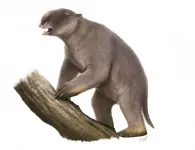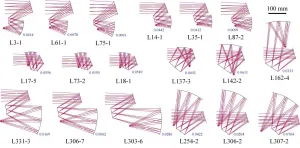Megafauna extinction mystery - size isn't everything
2021-04-13
(Press-News.org) Ancient clues, in the shape of fossils and archaeological evidence of varying quality scattered across Australia, have formed the basis of several hypotheses about the fate of megafauna that vanished about 42,000 years ago from the ancient continent of Sahul, comprising mainland Australia, Tasmania, New Guinea and neighbouring islands.
There is a growing consensus that multiple factors were at play, including climate change, the impact of people on the environment, and access to freshwater sources.
Now, research led by Professor Corey Bradshaw of Flinders University and the Australian Research Council Centre of Excellence of Australian Biodiversity and Heritage (CABAH) has used sophisticated mathematical modelling to assess how susceptible different species were to extinction - and what it means for the survival of creatures today.
Using various characteristics such as body size, weight, lifespan, survival rate, and fertility, they created population simulation models to predict the likelihood of these species surviving under different types of environmental disturbance.
Simulations included everything from increasing droughts to increasing hunting pressure to see which species of 13 extinct megafauna, as well as 8 comparative species still alive today, had the highest chances of surviving.
Published in the journal eLife, Bradshaw and his team compared the results to what we know about the timing of extinction for different megafauna species derived from dated fossil records. They expected to confirm that the most extinction-prone species were the first species to go extinct - but that wasn't necessarily the case.
While they did find that slower-growing species with lower fertility, like the rhino-sized wombat relative Diprotodon, were generally more susceptible to extinction than more-fecund species like the marsupial 'tiger' thylacine, the relative susceptibility rank across species did not match the timing of their extinctions recorded in the fossil record.
"We found no clear relationship between a species' inherent vulnerability to extinction -- such as being slower and heavier and/or slower to reproduce -- and the timing of its extinction in the fossil record", explained Professor Bradshaw.
"In fact, we found that most of the living species used for comparison -- such as short-beaked echidnas, emus, brush turkeys, and common wombats-- were more susceptible on average than their now-extinct counterparts."
The researchers concluded that the true extinction cascade was likely the result of complex, localised scenarios, including impacts of regional climate variation, and different pressures from people across regions.
Associate Professor Vera Weisbecker of Flinders University and co-author of the study said: "The relative speed of different species to escape hunters, as well as whether or not a species dug protective burrows, also likely contributed to the mismatch between extinction susceptibility and timing.
"For example, fast-hopping red kangaroos still alive today might have had an escape advantage over some of the slower-striding short-faced kangaroos that went extinct. Small wombats that dug burrows might also have been more difficult for people to hunt than the bigger, non-burrowing megafauna."
Co-author Dr Frédérik Saltré of Flinders University added: "We determined that the kangaroo species were the least-susceptible to extinction based on their biology, followed by the monotremes (echidnas), and the giant 'wombat' species. Interestingly, the large, flightless birds, like emu and the giant mihirung 'thunderbird' Genyornis, had the highest susceptibilities.
"Our results support the notion that extinction risk can be high across all body sizes depending on a species' particular ecology, meaning that predicting future extinctions from climate change and human impacts aren't always straightforward based on the first principles of biology", concluded Professor Bradshaw.
INFORMATION:
[Attachments] See images for this press release:

ELSE PRESS RELEASES FROM THIS DATE:
2021-04-13
April 13th, 2021, Washington, D.C. - The severe health and economic impacts of the COVID-19 pandemic have disrupted food systems and upended livelihoods. Yet pandemic responses have demonstrated the power of well-crafted policies to blunt the impact of major shocks while laying the groundwork for stronger, more resilient food systems, according to the 2021 Global Food Policy Report, released today by the International Food Policy Research Institute (IFPRI). The report provides lessons drawn from the current crisis that can help us transform food systems to reduce the impact of the ongoing pandemic, better prepare for future shocks, and address longstanding weaknesses and inequalities.
"We have known ...
2021-04-13
In the early time of optical design, people have to be proficient in aberration theory and perform a huge amount of numerical calculations, and thus mathematical skills and talents are very important. The emergence of electronic computers has freed people from heavy calculation tasks, and realized fast real ray tracing and been able to solve complex aberration equations. Since then, the application and development of optimization algorithms and optical design software have greatly improved the speed and effect of optical design. However, optical design still requires to solve or find an initial solution as the starting point of optimization, which will greatly determine the final result of optimization. Moreover, optimization is essentially ...
2021-04-13
The top priority in the field of transplantation is to ensure that donor organs are allocated to the patients with the greatest need.
In a large-scale joint international project conducted by the Medical University of Vienna and the Mayo Clinic in Rochester (USA), researchers from the Department of General Surgery and the Division of Gastroenterology and Hepatology of MedUni Vienna's Department of Medicine III, have made a significant step forward to improve prediction of survival on the waiting list for liver transplantation by including additional laboratory parameters.
Donor ...
2021-04-13
In recent years the boom in streaming platforms and video on demand services has led to disruption in audiences, representing a difficulty when measuring the number of viewers of the content distributed by these platforms.
This new situation has not only altered the traditional television and film viewing model, but also has impacted the advertising market, which is a fundamental factor in funding and the business of audiovisual entertainment.
In this context, real and objective audience measurement (which is not influenced by the interests of the platforms) has become a key objective; it is fundamental to obtain real-time data on the reach of each production ...
2021-04-13
When trees die during a period of drought, they die of thirst. Researchers from the University of Basel have demonstrated in a field study that a rapid collapse in the hydraulic system is responsible for tree death. And they found out that the trees possibly die more rapidly than previously thought.
The heatwave of summer 2018 was an exceptional situation - both for nature and for research. Although admittedly hard on our native woods, it also presented an opportunity for researchers at the University of Basel to closely study the reaction of trees to this weather phenomenon.
The research group led by Professor Ansgar Kahmen had already set up a research area in the Basel-Landschaft municipality of Hölstein the previous year. Their aim was to study the tree ...
2021-04-13
Misinformation in public debates about scientific issues such as vaccinations and climate change can be found all over the internet, especially on social media. In a new study, Sara K. Yeo, associate professor of communication at the University of Utah, examines why it's so difficult to detect science misinformation and suggests that using humor may help combat the issue.
In the article, published in Proceedings of National Academics of Sciences, Yeo and her colleague Meaghan McKasy, assistant professor of communication at Utah Valley University, argue that limited science and media literacy combined with structural constraints such as fewer ...
2021-04-13
Low-dimensional colloidal quantum dots (CQD) have attracted significant attention because of their unique structures, extraordinary optical properties, and low-cost preparation processes. Since its first synthesis in the 1990s, motivation to realize high-performance low-cost CQD micro-/nanolasers have been a driving force for more than three decades. However, the low packing density, inefficient coupling of CQD with optical cavities, and the poor thermal stability of miniaturized complex systems make it challenging to achieve practical CQD micro-/nanolasers, especially to combine the continuous working ...
2021-04-13
Osaka, Japan - Fluorescence spectroscopy is indispensable in biomedical diagnostics. One can think of turning on fluorescence as turning on a flashlight in a dark room. A diagnostic assay can be designed to label, for example, a specific molecule of DNA with a fluorescent probe. If that specific molecule of DNA is present, you see fluorescence or a change in the fluorescence.
Sometimes an otherwise fluorescent molecule stops emitting light for a brief period of time. This is called fluorescence blinking, which can make it difficult to detect biomolecules at the ultralow concentrations ...
2021-04-13
Human blood contains several different components, including plasma, red blood cells (RBCs), white blood cells (WBCs), and platelets. Among these, WBCs are divided into numerous subcategories each with unique functions and characteristics, such as lymphocytes, monocytes, neutrophils, and others. Lymphocytes are further subdivided into T lymphocytes, B lymphocytes, and NK cells. Distinguishing and separating different types of these cells is highly important in carrying out studies in the field of immunology.
Discriminating different immune cell types is typically done by flow cytometry and fluorescence-activated cell sorting (FACS), which can identify distinct populations ...
2021-04-13
CHAMPAIGN, Ill. -- In a state with greater income inequality, the happiest place to occupy is not at the pinnacle of the income distribution, as one might think, but somewhere in the middle that provides clear vantage points of people like ourselves, a new study suggests.
According to sociologist Tim Liao of the University of Illinois Urbana-Champaign, it's the ability to compare ourselves with people of similar backgrounds, both people who earn more and others who earn less, that determine how our income affects our happiness - not the absolute amount we earn.
"Contrary to popular belief, more income does not necessarily make people happier. The actual amount a person earns doesn't matter much in terms of happiness," Liao said. "People who can make both upward and ...
LAST 30 PRESS RELEASES:
[Press-News.org] Megafauna extinction mystery - size isn't everything





